Robotics Education Journal
 05/17/2018
05/17/2018 In an article published in the June 2018 issue of The Atlantic, Dr. Henry Kissinger summarizes, in a fascinating and sweeping essay, the several stages of technological innovation in human history, moving from the age of religion to that of reason, then to the ideological obsessions of the 20th century, and then to the present. He looks at the recent AI developments that have seen computers defeat the best human players of the ancient board game, Go. He concludes humanity is unprepared for the coming technological plunge into all things AI.
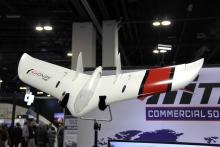 05/15/2018
05/15/2018 HitecRCD, www.HitecRCD.com, is an industry-leading provider of radio control (RC) radios, servos, and chargers that has been a provider of affordable, high-quality, innovative consumer RC products for the hobby and other markets since its beginnings in 1983.
In 2017, the company created a new division, Hitec Commercial Solutions, www.hitecnology.com, to service industrial actuator markets. Several new products developed by Hitec for commercial markets were shown at the recent Xponential 2018 conference and trade show on all things robotics in Denver, CO. These included new actuators, electronics accessories and, notably, the new XENO FX fixed wing drone that provides extensive aerial survey data using a variety of sensors – for customers in multiple business markets.
At the recent Xponential 2018 show in Denver, iSENSYS showed a full suite of air, land and sea machines, including Polaris dune buggies and a modified helicopter as well as a jetski, all of which were target drones for gunnery and related targeting practice. The large black unmanned ground vehicle (UGV) had a faceted surface with embedded sensors in the facets. This drone reports where it was hit by incoming fire and the angle and force of the impact, providing important feedback to military developers.
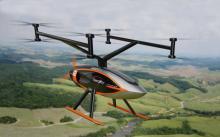 05/09/2018
05/09/2018 At the recent Xponential 2018 show in Denver, the Aergility booth (3136A), showed a new multirotor electric autogyro design that uses 8 rotors with large props mounted in double pods on the upper perimeter of the aircraft. This remarkable machine, propelled by an aft pusher prop, flies like an autogyro! The 8 forward propellers, aka rotors, generate lift based on horizontal airflow. Our understanding is that famed aerobatic heli pilot Bobby Watts contributed to the development of this design.
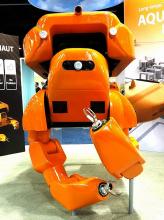 05/07/2018
05/07/2018 The AUVSI Xponential 2018 conference was held April 30 – May 3 at the Colorado Convention Center in Denver, CO. Over 600 companies representing the latest world-class technology unveiled robots, location and navigation systems, ISR technology and much more. NREF will soon be posting hundreds of photos of this exciting event. Here are a few images that hint at the diversity of robots shown at this fantastic conference and trade show.
 04/18/2018
04/18/2018 At the ACM/IEEE International Conference on Human Robot Interaction (HRI) last month, roboticists from the University of Washington in Seattle presented a paper entitled “Characterizing the Design Space of Rendered Robot Faces.” Researchers looked at 157 different robot faces, using 76 evaluation dimensions, and statistically analyzed the results.
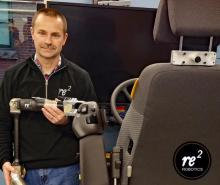 04/10/2018
04/10/2018 Pittsburgh-based RE2 Robotics announced a “Rapid Airfield Damage Recovery Robotic System” under a new U.S. Air Force contract. The system is a drop-in kit that converts a traditional construction vehicle into an unmanned remotely controlled (teleoperated) vehicle.
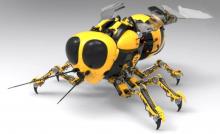 04/07/2018
04/07/2018 NASA is looking at robot “bumblebees” that will be used to explore and map local areas on mars in advance of human visitors. The concept robot bee shown may not illustrate the very large wings that would be used on a flying robot designed to fly in the very thin Martian atmosphere. This concept prototype, named “Marsbee,” is one of 25 of the latest NASA-funded NIAC Awards for 2018.
As robots proliferate, we encounter them more and more often in our daily routines. This Knightscope K5 was recently spotted by Thomas Marsh, director of business developments and insights at Broadridge, in Terminal B at LaGuardia International Airport. Marsh noted it was kind of interesting to see this nearly 400-pound robot rolling around “collecting sounds and video for your security.”
 03/28/2018
03/28/2018 Attend the Smart Manufacturing Experience conference, April 30 – May 2, 2018, at the Boston Convention Center, Boston, MA, to learn how Big Data, smart manufacturing and artificial intelligence are revolutionizing the way companies work, innovate and do business. Real-world case studies will show how leading companies are increasing productivity using robotics and related transformative technologies.
Keynotes will explore how Big Data, smart manufacturing and artificial intelligence (AI) are enhancing the way leading firms work, innovate and do business. Speakers from Twitter, Microsoft, GE Ventures, MIT and other innovation centers will explore how these transformative technologies are changing the face of business.
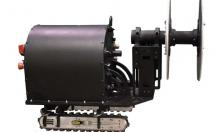 03/20/2018
03/20/2018 A pair of autonomous robots developed by Carnegie Mellon University’s Robotics Institute will soon be driving through miles of pipes at the U.S. Department of Energy’s former uranium enrichment plant in Piketon, Ohio, to identify uranium deposits on pipe walls.
 03/14/2018
03/14/2018 Keith Shaw of Robotics Business Review reported last Friday that researchers from IOActive had demonstrated proof of concept ransomware attacks on the popular Pepper and NAO humanoid service robots. The attack was done via a public Wi-Fi network and, interestingly, could be replicated and fine tuned in simulation software.
 03/11/2018
03/11/2018 In April, two 7-meter maritime surface drones will return to California after an 8-month trip testing technology destined to replace the buoys that in recent years have looked for signs of El Niño. Manufacturer Saildrone, based in Alameda, CA, developed the drones in close collaboration with the National Oceanic and Atmospheric Administration (NOAA) in Washington, D.C. Each drone carries a suite of 15 instruments measuring wind speed, air temperature, sunshine, sea-surface temperature, wave heights, carbon dioxide, oxygen, salinity and ocean currents up to 100 meters deep (via a sonar-like Doppler profiler).
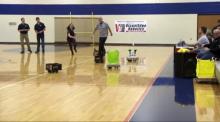 03/03/2018
03/03/2018 Robotics Football began in 2011 as a senior design project for engineering students at Notre Dame in Indiana. It has since grown into an annual midwestern tournament involving six universities. Notre Dame’s Fighting Ibots team is shown in a competition with a team from Purdue University, which has been their top in-state rivals. In this latest competition, Notre Dame acknowledged that Purdue fielded “really quick” robots, which are a challenge on defense. Notre Dame featured its new, reengineered center robot, which better aligns the quarterback and center players for more precise play in a scrimmage.
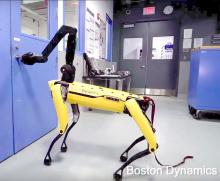 02/24/2018
02/24/2018 Boston Dynamics has become famous owing to its robotic dogs, humanoids and payload carrying vehicles. In a new twist, the company shows a robot that can navigate office and warehouse doors. After a technician gives the “Go” command, SpotMini autonomously grasps a door handle and opens a heavy warehouse door with ease.
 02/18/2018
02/18/2018 As reported by C4ISRNET, U.S. Secretary of Defense Jim Mattis offered some comments on Feb. 17 on the nature of combat and on the role of AI. As for the “fundamental” nature of comment, Mattis commented that “It’s equipment, technology, courage, competence, integration of capabilities, fear, cowardice — all these things mixed together into a very fundamentally unpredictable fundamental nature of war,” Mattis explained... “The fundamental nature of war is almost like H20, ok? You know what it is.”
In response to a question on the impact of AI on the nature of war might be, C4ISRNET reported that Mattis responded: “I’m certainly questioning my original premise that the fundamental nature of war will not change. You’ve got to question that now. I just don’t have the answers yet.” He continued: “The character of war changes all the time. An old dead German [Carl von Clausewitz] called it a ‘chameleon.’ He said it changes to adapt to its time, to the technology, to the terrain, all these things.”
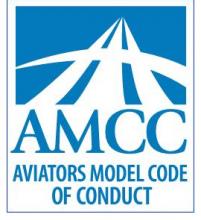 02/12/2018
02/12/2018 The UAS PILOTS CODE (UASPC) offers recommendations to advance flight and ground safety, airmanship, and professionalism. It presents a set of recommended practices—a vision of excellence—to help UAS pilots interpret and apply standards and regulations, and to confront the real world challenges to avoid mishaps. It is designed to help UAS pilots develop standard operating procedures, effective risk management, safety management systems, and to encourage UAS pilots to consider themselves aviators and participants in the broader aviation community.
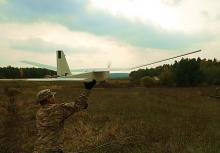 02/06/2018
02/06/2018 As stated by Walter O’Brien, CEO of Scorpion Computer Services, whose AI system runs and protects the Army’s UAV operations: “Now I have an AI protecting the data center, and now the enemy would have to have an AI to attack my AI, and now it’s which AI is smarter…”
 01/25/2018
01/25/2018 As we head into Drone symposium season, sUAS News is pleased to announce that we will be presenting the sixth annual SUSB Expo. Way back in 2013, few believed that there was a commercial interest for drones. We knew better and launched a live event where industry professionals and our readers can network and discuss the business of drones.
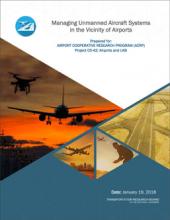 01/24/2018
01/24/2018 TRB's Airport Cooperative Research Program (ACRP) has released a draft document titled, "Managing Unmanned Aerial Systems (UAS) in the Vicinity of Airports" that provides guidance for airport operators and managers to manage UAS operations and related activities in and around airports.
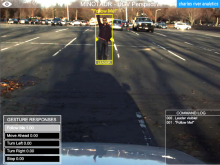 01/18/2018
01/18/2018 The Armed Forces have pursued R&D for years on unmanned ground vehicles (UGVs) that can semi-autonomously carry payloads of supplies across rough terrain in both combat and search and rescue environments. The common challenge is active teleoperation (remote control) of the robot UGVs. Traditional “heads down” operation of tablet menus to control UGVs is tiring and reduces situational awareness. A solution is an intuitive soldier-machine interface named MINOTAUR that has been developed by Charles River Analytics and partner, 5D Robotics.
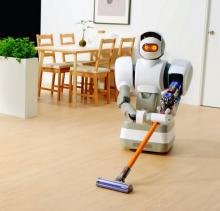 01/15/2018
01/15/2018 One of the charmers at the Consumer Electronics Show in Vegas (CES) was a new robot from Aeolus that can not only clean floors but also accomplish the legendary mission of household robots: it can fetch a beverage from your refrigerator and hand it to you. Aeolus is a global company with offices in San Francisco and Taipei City, and it has formidable credentials – over 100 engineers on staff and decades of experience, including “conceiving and managing the historic Watson AI project.”
“This is the first multi-functional robot that can act like a human being,” said Alexander Huang, Global chief executive of Aeolus Robotics. “Right now it’s like a child, but we will continue to grow its capability so that it grows from a child to an adult. The more people that use the robot, the stronger it becomes.”
 01/10/2018
01/10/2018 As recently announced by the Association for Unmanned Vehicle Systems International, “AUVSI's Startup Showdown is back for the third year and is better than ever! The Startup Showdown is your opportunity to present your new innovations to investors and the unmanned systems community.” Please note that the deadline for enrolling is Friday, January 26!
 01/06/2018
01/06/2018 The IEEE recently published three standards for consideration in the development of ethically sound automated systems employing artificial intelligence (AI). Given the rapidly emerging presence of AI in the Internet of Things (IoT) and across the board, these principles offer timely, relevant guidance to those designing automated systems and related applications.
 01/04/2018
01/04/2018 It was reported by TheHill.com that two recently publicized computer chip hardware vulnerabilities are causing grave security concerns to corporations, educational institutions, online associations of all types and even governments, across the board. These vulnerabilities are said to give hackers opportunities to access confidential information from “virtually all modern computing devices, ranging from computers to smartphones to cloud infrastructure.”
